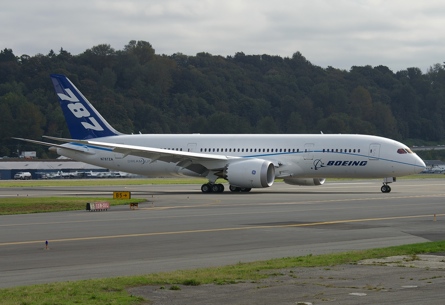Boeing's sixth and final 787 Dreamliner has successfully completed its long-delayed maiden sortie, despite being cut short by a liquid cooling leak, programme sources indicate.
The aircraft, which is the second of two General Electric GEnx-1B-powered 787's, departed Boeing's Paine Field in Everett, Washington at 11:41 PDT (18:41 GMT) on 4 October and lasted just over an hour with an aircraft recovery at 12:45 PDT at Boeing Field in Seattle.
Captains Christine Walsh and Bill Roberson were at the controls for the aircraft's first flight.
The flight had been initially slated for several hours but was abbreviated following a "maintenance issue" and "as a pre-cautionary note decided to land at Boeing Field" instead of proceeding toward a planned intermediate stop at Grant County International Airport in Moses Lake, Washington, says Boeing.
Programme sources say a liquid cooling leak encountered at 39,000ft prompted the early conclusion to the flight. The 787's electronics are liquid cooled. Boeing was not immediately available for comment on the matter.
| |
|---|---|
©Joe Walker |
"A flight of this length is still considered a successful first flight and we are proud to have the sixth and final flight test airplane enter the programme today," says Boeing.
Pre-mature conclusions to B-1, or first Boeing evaluation, test flights are not entirely uncommon for even mature aircraft programmes such as the 777, which is built one assembly bay over from the 787, though the extreme interest in the long-delayed programme has made its every movement subject of great scrutiny.
Boeing initially planned to have ZA006 flying in June, but the aircraft's first flight had been inexplicably delayed several times, pushing its first flight to more than 10 months after the flight test programme first began in December.
Boeing initially cited "software" for the slide, later saying that the aircraft had been less of a priority with its role duplicating functions of other test aircraft, finally concluding that ZA006 faced unspecified "challenges" on heading into its first flight.
The aircraft is fitted with minimum data systems and will primarily be tasked with lightning/eletromagnetic effects (EME) and high intensity radiated field (HIRF) testing.
Additionally, ZA006 will be tasked with further extended twin-engine operations (ETOPS) testing, as well as systems functionality and reliability (F&R) evaluations.
Testing in extreme weather conditions and noise evaluations will be undertaken using the GEnx fleet, to ensure identical performance and handling to that of the Rolls-Royce-powered 787s.
The airframer says it has completed more than 1,900h of testing over 620 flights with 65% of flight test conditions completed for the Rolls-Royce powered fleet. Additionally, Boeing has logged "well over" 4,000h in ground testing on the test fleet, well in excess of the 3,700h initially stated would be required for certification.
Lastly, Boeing has completed 15 simulated cycles on its 787 fatigue test airframe since it began evaluating the long terms structural life of the aircraft on 13 September. ZY998 as it has been dubbed, will lead the fleet leader by 10,000 cycles at the time of entry into service next year.
Boeing aims to deliver its first 787, a Rolls-Royce Trent 1000-powered example, to Japan's All Nippon Airways in the middle of the first quarter of 2011. Boeing has declined to say when the first GEnx-powered 787 will be delivered or to what operator, though it is believed that Royal Air Maroc or Japan Airlines is the likely first recipient.
Source: Air Transport Intelligence news
























